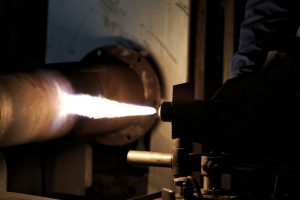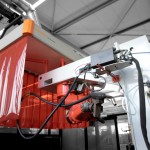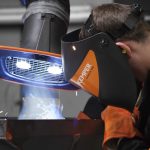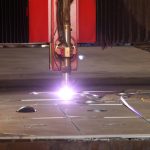Thermal spraying: Closed booths with extraction are essential
Depending on the process, thermal spraying causes a large amount of hazardous substances and a lot of noise. This means one thing above all else: High demands placed on occupational health and safety – because although thermal spraying processes are mostly carried out automated or semi-automated in booths, there is still a health risk for employees at surrounding workplaces that should not be underestimated.
Whether repairing worn parts, corrosion protection or adjusting the electrical conductivity and other surface functions: Thermal spraying is a flexible and established process in different industrial sectors, which is characterised not least by its high economic efficiency. In thermal spraying, a powder or wire coating material is melted and “sprayed” onto the base material at high speed. On impact, the individual particles combine to form a compact layer on the base material.
 The main thermal spraying processes include flame spraying, arc spraying and plasma spraying. The main difference between them is the energy source. Either a fuel gas-oxygen flame, an electric arc or a plasma or laser beam are used. A health risk
The main thermal spraying processes include flame spraying, arc spraying and plasma spraying. The main difference between them is the energy source. Either a fuel gas-oxygen flame, an electric arc or a plasma or laser beam are used. A health risk
During the spraying process, part of the molten spray additive misses the workpiece and another part rebounds. This also produces fine dust particles that are released into the ambient air. While the base material has no influence on the quantity and composition of harmful substances, the respective process and the additives used become even more important. For this reason, the capture and separation of hazardous substances is necessary. Only sufficient protection will ensure that the dust concentration in the breathing zone does not exceed the general dust limit value – for both the A and E fractions.
Flame spraying and arc spraying: Danger from nitrous gases and chromium (VI) compounds
Flame spraying with wire or powder spray additives always produces gaseous and particulate hazardous substances. Their composition corresponds to that of the spray additive: If, for example, a zinc wire is used, zinc oxide smoke is formed. As with other autogenous processes, nitrous gases are also created. If high-alloy spray additives such as chromium or nickel are used in flame spraying, high concentrations of carcinogenic nickel oxide and chromium (VI) compounds are formed as dust.
During arc spraying, large quantities of particulate hazardous substances are produced whose particle diameter is smaller than during flame spraying. This results in a larger alveolar fraction and means a higher number of particles with a size of less than about 2.5 µm that can penetrate the lungs and alveoli where they can settle and cause damage. Arc spraying with chromium-nickel or nickel-based spray additives also produces nickel oxide.
Plasma spraying: Largest quantity of harmful substances of all spraying processes
Plasma spraying produces a significantly higher emission of harmful substances than the other two processes if the same spray additives are used. The reason for this is the much higher injection speed that is more than twice as high as flame and arc spraying. Depending on the addition, breathable A and E dusts such as nickel oxide, copper oxide or cobalt oxide, but also ozone in quantities that significantly exceed the applicable occupational exposure limit values (OEL) or, in the case of carcinogenic substances, the assessment criteria (ERB values).
Thermal spraying ideally in closed booth only
 Companies should carry out all thermal spraying processes, especially plasma spraying, in enclosed booths due to the dangers of particulate hazardous substances. In the booths themselves, emissions should also be captured at the point of release as far as possible, so they do not spread inside. These booths should be operated at a slight negative pressure relative to the surrounding hall so that air can constantly enter the booth from the outside, thus preventing the escape of hazardous substances into the hall.
Companies should carry out all thermal spraying processes, especially plasma spraying, in enclosed booths due to the dangers of particulate hazardous substances. In the booths themselves, emissions should also be captured at the point of release as far as possible, so they do not spread inside. These booths should be operated at a slight negative pressure relative to the surrounding hall so that air can constantly enter the booth from the outside, thus preventing the escape of hazardous substances into the hall.
Due to the high particle speeds and quantities of hazardous substances, correspondingly high collection speeds are required during extraction (see VDI 2262, Sheet 4 “Capturing foreign substances in the air”). This combination of spray booth and extraction system not only protects the surrounding workplaces from smoke and dust, but also reduces the noise level caused by thermal spraying.
Thermal spraying in semi-open and open environments
If thermal spraying cannot be carried out in closed booths but in semi-open booths, for example, companies must ensure that the working area is completely within the inflow range of the ambient air. Semi-open, for example, are booths with a permanently open side for access to the workpiece.
Employers can also take noise protection measures here at the same time by lining the booth with an inner soundproof lining. If thermal spraying is only possible in the open due to particularly large workpieces, for example, the working area should be restricted as far as possible by mobile walls and the hazardous substances should be extracted in the spraying direction by effective capture, e.g. by a vortex hood.





